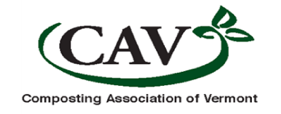
by Althea Deschenes
To appeal to people of all ages, the poster was painted with bright colors. Elements of the poster, such as the tree with flowers and the rainbow caterpillar are not realistic, but this is to exaggerate the benefits of compost on gardens and home ecosystems. Fantastical elements also serve the purpose of inspiring the viewer to use compost on their gardens to see what improvements can be made. Scraps illustrated in the compost pile are common wastes, coming from households, small restaurants, offices, barns and yards. The diversity of feedstocks in the pile highlights that everyone, despite differences in lifestyle or location, produces waste that can be composted. Most of the poster is soil, which depicts microbes and fungi in it. Depicting the small organisms in the dark soil is important in displaying that soil is alive, functioning and thriving from the compost. The shovel represents the work that must go into creating a successful compost pile. It serves as a reminder that creating good compost requires effort and the practice should be appreciated. Overall, the poster has a very circular layout. The purpose of the organization is to mimic a closed circular system (relating the poster and compost to “closing the loop”). The bee seen at the top of the poster represents the link between the environment and human systems; the pollinators use what we grow to help produce more food. I hope to convey the idea that by composting, we can benefit the environment is ways that will in the long run benefit our own soils and food systems.

by Ernesta McIntosh
For my poster I used acrylic paints on canvas to create my design and then added the text on the computer. I focused on bright colors to create an eye catching design that would convey positivity and hope. My goal was to highlight the vibrancy and life involved in the natural cycle of composting. In the top left is the sun which provides the energy for all life processes and allows items to decompose into compost. That compost is then added to soil to enrich it and allow for new sprouts. On the bottom right of the poster is a compost pile that illustrates some materials that can both be composted and grown from compost. I also painted sprouts which exemplify the new growth that can be produced from the soil. This poster is meant to be a colorful celebration of the cycle of life, and the creation of growth from decay.

By Brianna Borch
I used my food scraps and compostable household materials generated from the past week to create a nature scene. I started with the background of a brown paper bag, and then used banana peels, tea leaves, and corn husks to represent layers of soil. To show how beneficial compost is to soil, I crafted plants growing from this compost soil from old lettuce leaves, pieces of pineapple stem, sliced up portions of an egg carton, and bay leaves. Lastly, I added in the sky, using clementine peels, egg shells, and pineapple rind slices, to represent the fact that using compost in our soils provides ecosystem services that benefit the atmosphere as well. This project was really fun, and I hope it does justice to the benefits of using compost in our soils!

by Leany Munoz
The idea is the compost feeds soil nutrients necessary to decompose organic material adequately, to nourish rich crops. The concept here is demonstrated with a carrot and a beetroot “falling in love” making connections through what appear as strong and well connected roots. The compost pile immediately on top has a few apparent food scraps, and behind it is another large compost pile. The idea is again, that the relationship between compost and soil creates healthier crops, and therefore resembles a sort of “loving” relationship.

by Malachi Witt
The overall goal of the poster is to show compost use in completing nutrient cycles (the green arrows) and the benefits of compost on soils. The top left part of the poster shows healthy soils supporting healthy plants and animals which produce feedstocks for more compost (shown on the upper right ). The bottom part of the poster completes the cycle demonstrating compost use in creating physical (background soil structure), biological (cartoon worms and mites), and chemical (nitrate, magnesium, and potassium) components of healthy soil.

by Irene Reichl
I used a piece of a cardboard box as my canvas, then wrote "SOIL [heart] COMPOST" and filled everything in with food scraps from our compost bin. I tried to convey the concept that you can also use paper goods in your compost bin by including a paper towel and a coffee filter. I used coffee grounds as soil for a little flower I drew, because coffee grounds resemble finished compost. I added some flowers I found in my yard to represent growth from using compost in your soil.

by Leah Corbin
I decided to make art from materials that you would use to build a healthy soil through composting. The blue paint I used to make the words is a paint I made from boiling blueberries, that way the whole poster can be composted. I didn't use glue for the materials since the physical poster will not be hung up, but I would've made a sugar syrup to act as a glue, going along with the compostable poster theme. The other materials consist of but are not limited to: a used coffee filter, stale popcorn, dead leaves from house plants, mustard seed, wooden shavings (this is what we use for our chickens, but I wasn't going to put dirty shavings on the poster), twigs, old food, and other miscellaneous dried items. These are all natural things that came from the soil, and show that the soil loves compost because it is what helps to grow and produce all of these materials.

by Bay Burnham
I wanted to incorporate light spring colors in the poster because International Compost Awareness Week is in May (spring). The photo that encompasses the background of the poster is my own. I chose it because it represents a spectacular, budding garden. To me, the phrase “soil loves compost” means compost is a source of growth and beauty. It can heal damaged soil and rebuild struggling ecosystems--that’s powerful. “Soil Loves Compost” makes me think of the soil process as a whole. Because I felt that I could not portray the entire compost cycle in my poster, I wanted to show the end result of what using compost really means. The end result here provides a sense of giving back to the environment. By “giving back”, I mean that compost replenishes the natural, essential ecosystem tasks which have recently been broken. “Soil Loves Compost” means reinvesting in an ecosystem balance, creating a safe space for native species (like pollinators-depicted by the hummingbird), and looking toward a more sustainable future. Those were the ideas I wanted to symbolize in the poster I created for this project.

by Sarah Hornby
I chose this because it reminded me of a person loving food. This is why I chose to draw the soil with a physical mouth eating up all the good compost feedstocks from a compost bucket. These feedstocks included food scraps such as orange peels and apple cores and yard trimmings such as leaves. I also included worms in the soil because vermicomposting involves decomposition with help from various species of worms, usually red wigglers, white worms, or other earthworms. The mouth in the soil reminds me of Ashley Jr, the man eating Venus fly trap from Little Shop of Horrors. This is also a reminder that the earth beneath us is more alive than we perceive it to be.

by Gabby McCarthy
My poster shows composting as a constant cycle of nutrients with zero waste output. We grow food, we use and consume that food/compostable product, and then we compost it. This would ideally be returned to the soil to grow more produce. It is a simplification of the composting process, but highlights its benefits. It shows how we use our resources without negatively impacting the environment or producing unnecessary food waste. The hand holding soil in the center of the poster displays the importance of our involvement in this process. We can use and regenerate healthy soils/food through composting. Doing this creates healthier soils without added chemicals. Because of all these benefits, this fits with the theme of "soils love compost." I hope that my poster emphasizes the recycling nature of composting, which produces soils and crops continuously if utilized.

by Jay Lane
I started off my poster by creating a soil profile by grouping together little irregular shapes that I created with the shapes tool then converting the grouping to a picture and distorting it. I did the same with longer shapes to make the roots and half-moon shapes to make grass. My original idea was to anthropomorphize the soil with worms and rocks, but I realized I would run out of room for the text, so I left the soil as a simple profile. I then added red thought bubbles that grew into a heart to signify that the soil was loving something. To show compost, I took the cylinder shape, and distorted it to make it trash-bin shaped, then made a banana and apple using a combination of different shapes and the line editing tool. I added the green arrow to signify the apple and banana were being composted. I choose fruit in bin, rather than trying to create a compost-like image because I felt the fruit was more ubiquitous and compost would be hard to distinguish from soil visually.
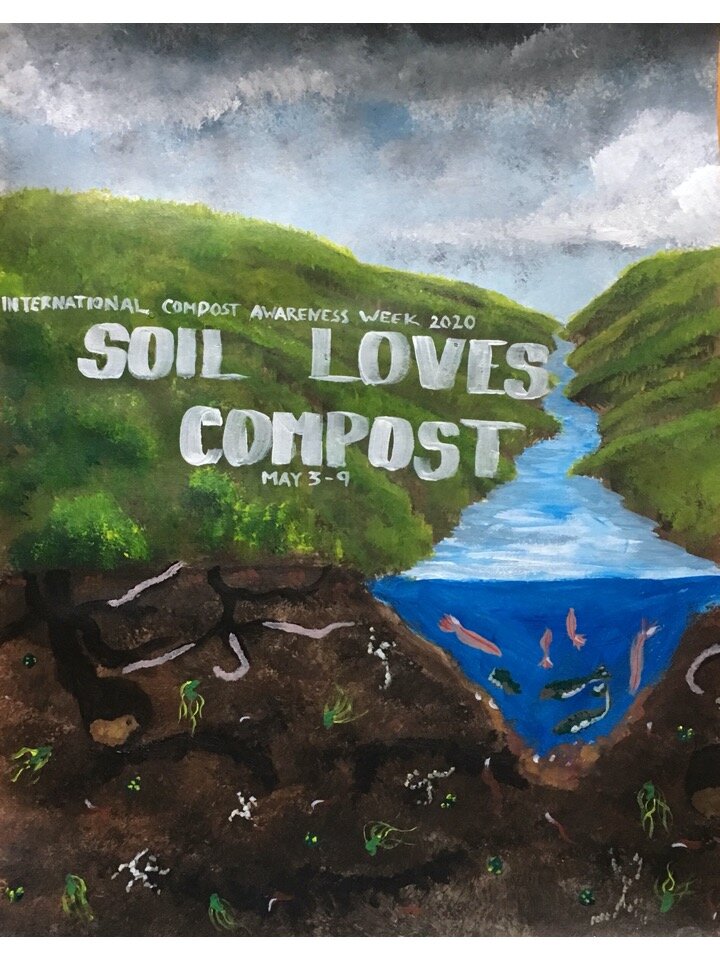
by Sophia Carlat
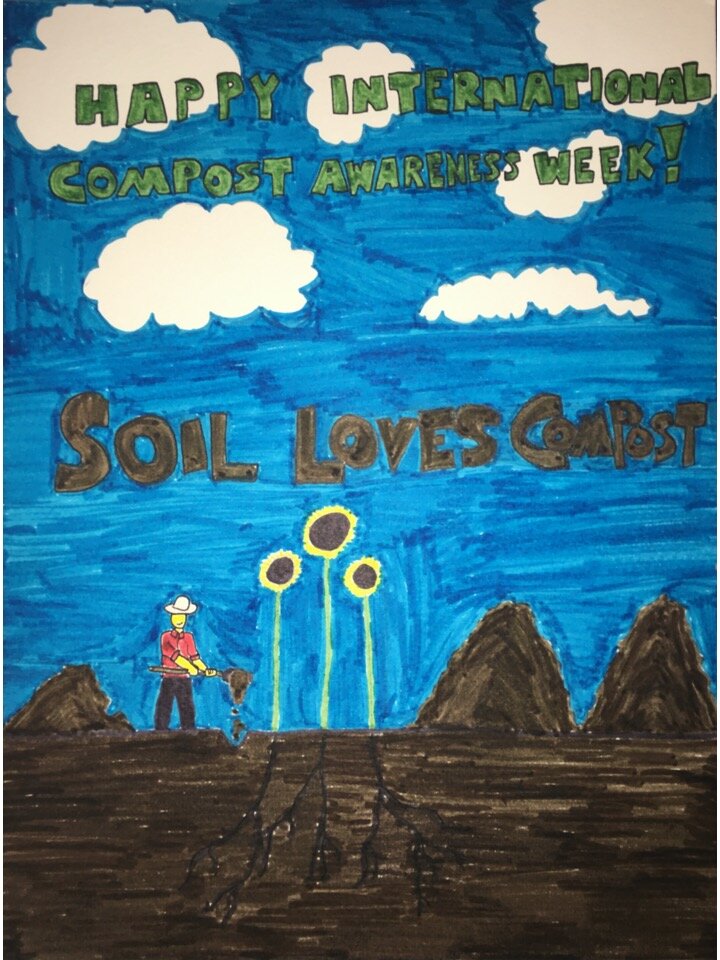
by Erik Faber
I wanted to depict the simple image that a few piles of compost can allow one farmer to grow plants that are deeply rooted and taller than himself. I thought that choosing three big sunflowers was a good representation of the yield and brightness something as simple as recycled organic matter can produce. I also sought to depict working with compost as something a single person can do, not just as an industrial or large-scale process.

by Olivia Hart
My poster displays the idea “Soil Loves Compost” because it displays a dry, unhealthy soil that becomes healthy and able to sustain plant growth when compost is added. The dry, nutrient poor soil is shown with much better texture, color, nutrient availability, and moisture once combined with compost. The poster aims to show aspects of compost like its ability to provide better soil structure to the soil and help soil retain water and nutrients. In addition, compost can also improve the pore size in clay soils, like the dry one on the top of the poster, which allows for greater infiltration. All of these aspects lead to improved plant growth in the soil as depicted as the new sprout grows out from the word compost. I composed this poster by taking five different images and editing them together. I edited the dry soil into the hands, placed the heart hands in between the two images, and cut the plant out to place it in the compost soil mixture.

by Paul Garcia-Beattie
The poster relates to compost and its effects on soil ecology in several aspects. You can see clearly the decomposing fruits in the sub-soil section as well as decomposing animal bones. The worms drawn are helping to break down the materials and creating a natural vermicompost. If you look closely on the left side in the background, near the mushroom patch there is a cow adding some healthy manure which further add to the compost mixture in nature. The soil drawn is a healthy mix supporting diverse growth which attracts pollinators such as bees and butterflies. There is also a dead log that is not completely decomposed, though it someday would be, that makes a nice home/hole for a fox to nest in. Overall, I felt this poster mixed together the different animal and plant life that adds and is helped by compost rich soil.

by Cameron Giroux
I designed my poster with soil as my main theme. I wanted the entire poster to look like a piece of the earth. This is why I used an entire background of rich earth, which could also look like some nice compost. I layered a silhouette of a corn stalk on top of the background to show a main use of compost, which is in agriculture. I kept my poster simple yet clean. It is easy to read. I chose a more dynamic font for the word compost to give the sense of the many ways it can be used.

by Leah Kelleher
My International Compost Awareness Week poster features the beneficial microbes that make compost-rich victory gardens possible. Microphobia is very common in our Western society and is often one of the major reasons why people are skeptical of recycling organic matter via composting. My poster tries to cut through this phobia by depicting some of the common soil microbes as little compost facilitators (depositing a decomposing eggshell and a strawberry into garden soil), The microbes featured in this piece include Dicyrtomina minuta-Collembola/springtail, a nematode, and diplura. I enlarged each microbe in an effort to make them more charismatic, and I drew them based off of “A Chaos of Delight” soil mesofauna photos by Andy Murray. Diplura helps form the word “garden” which is also composed of more nematodes, green and yellow seeds, and a red grub. Above the soil, a vibrant sprig of lavender grows tall -- emphasizing the health that mature compost can bring to garden plants. This message is also conveyed in the carrot growing amongst the microbes. Finally, a bumblebee flies towards the lavender in an effort to pollinate it while carrying the “victory” sign.

by Merisah Trisciuzzi
I really wanted to get across that the compost can become an integral part of the soil that can help plants grow, which is the reason that background fades from what is clearly food-scraps into healthy, lush looking soil. I tried to have some fun with the words as well; clearly making the connection that healthy soil produces healthy food by adding in the bell pepper, and the very obvious compost word (from a free, public access site, I cited the artist below). I had some fun with the word “loves” by just adding in a cupid and having it be made of hearts, just for the sake of being cute!
Reference: Krampien, Celia. 2019. Compost. Behance.net.

by MaryElena Bafundo
This poster shows the agricultural use of compost, which is the growth of corn. The compost pile is in the foreground of the poster, and it is filled with mature compost and some food scraps that have been added, while some worms eat the organic material. By composting food scraps, the soil can be used to grow agricultural food products like the corn seen in the poster. While we can biologically recycle our food scraps and divert our food waste from the landfill, we can also use this waste to give nutrients to our soil to make it better for plant growth. Soil loves compost because compost gives it the extra boost it needs to be extra healthy and grow plants.
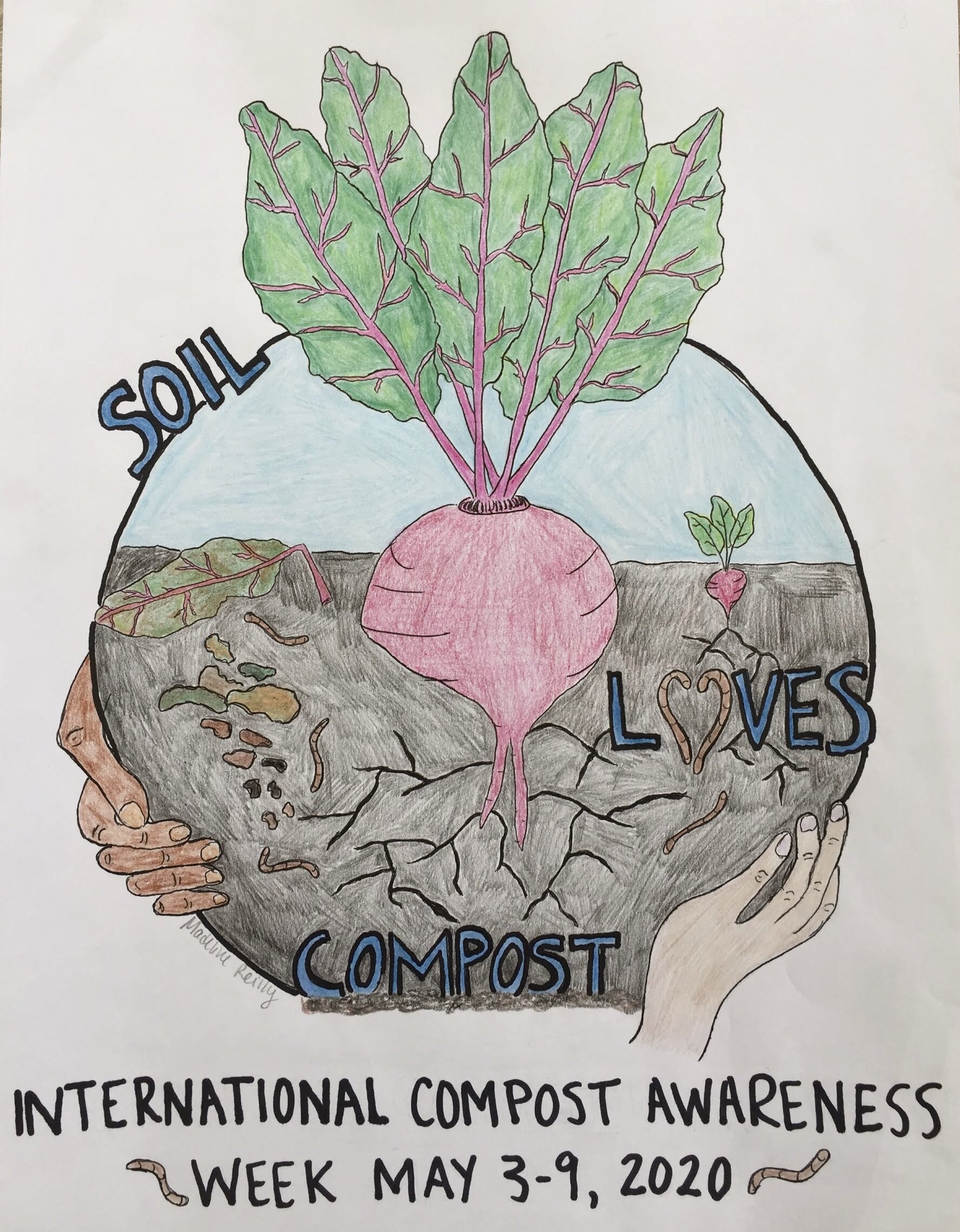
by Madeline Reilly
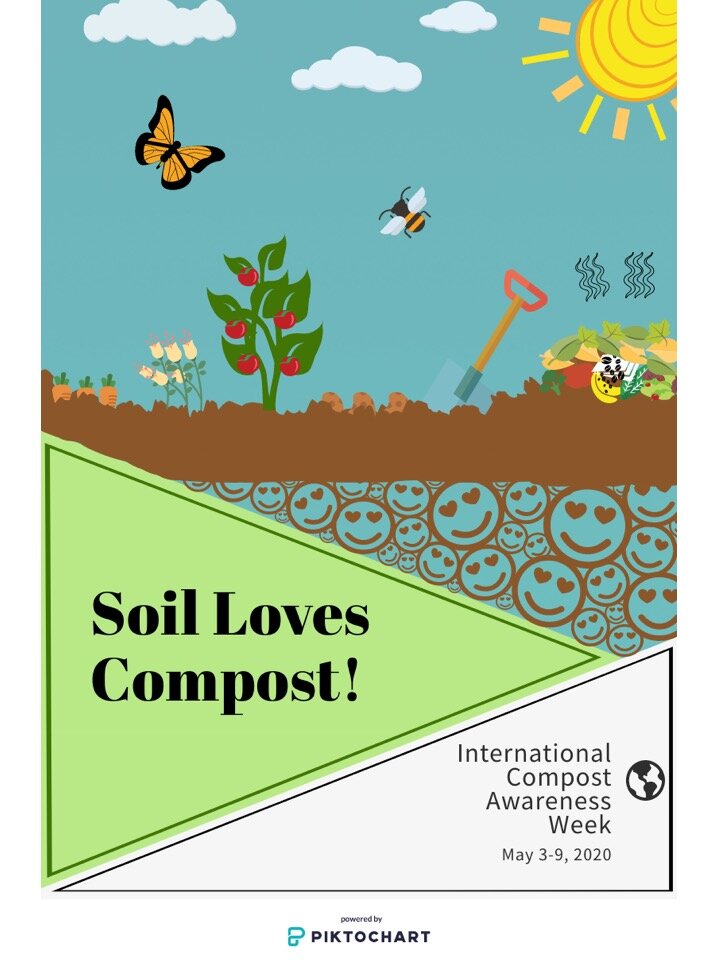
by Tess Eagens
I wanted to make a poster that was simple but also eye catching. I wanted to make it bright and light hearted. I made it bright by using bright colors and made it light hearted by using the smiley faces to show how soil loves compost. I also new from the beginning that I wanted to include a compost pile on my poster. I wanted it to also be educational on what kind of items can be composted. I used popular compostable items like fruits, vegetables, coffee grounds, paper, and leaves.
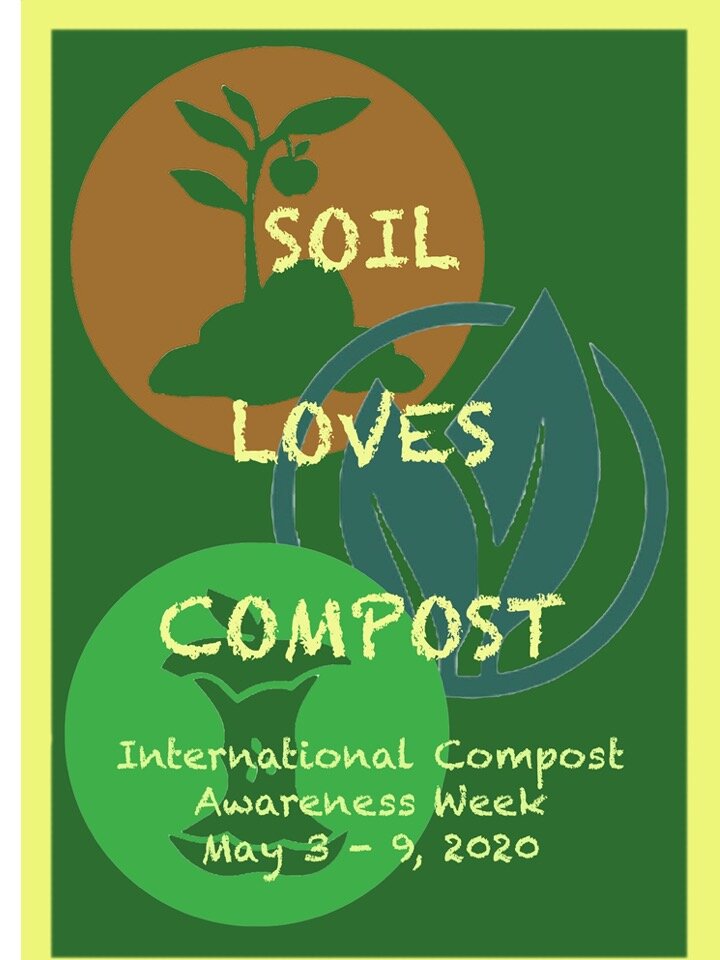
by Kyle Dorsey
I wanted to keep the poster simple and not too noisy so I stuck to 3 primary pieces of clip art. They are arranged behind the included phrase "soil loves compost" to represent the different parts of the phrase. Soil is represented by the plant growing in a mound of dirt in a soil like color. The word loves is represented by the paper waste symbol because I thought a heart looked too cheesy and decided to stick with a standard symbol. Finally the word compost is backed by the food waste symbol that most of us know and we see marking food waste collection bins in public areas. I feel it looks simple and informative and complete.






















